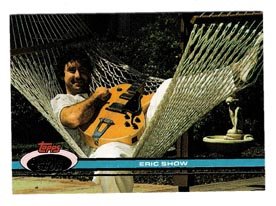
I remember the big selling point was the seemingly fantastic photography (Topps even made a point of putting the Kodak logo on the pack), but while I sit here tonight opening these packs, the photos aren’t that great. Maybe it was a big deal because there are no borders on the photos, because the photos themselves aren’t really anything special. I would say the two biggest things about these cards is that they’re glossy without feeling cheap (unlike, say, the Kay-Bee Toys deck of card sets from the late Eighties), they feature a full color back and they showcase the player’s rookie card on the back. This last feature kicks ass. And I would even go so far as to say that it was the best thing featured on the back of a card since the Play Ball game on the backs of the 1978 set. That’s a span of 14 years. Can you name anything on the back of a card since this set that makes you excited to buy more of that set? Seriously. I can’t think of any.

Here’s a quick rundown of the eight packs: 96 cards. 23 good cards. 1 fun card of Eric Show doing something other than playing baseball (the photo was obviously taken by Show’s wife or girlfriend…and by the way, wouldn’t it be better if card companies just employed the Sears Portrait Gallery as their official photographer? I think it would’ve made for some great photos, especially any with the perennially grumpy Sparky Anderson…I’m thinking one part oversized, droopy bowtie, one part checkered blazer and three parts hair pomade (applied liberally)). 1 checklist. 0 Red Sox, but 1 Dwight Evans on the Orioles. Not bad. Plus, I think they used the same photo for Bo Jackson that they used on his immortal 1987 Future Stars card.
17. 1988 Topps Traded
Speaking of sets that I wanted but couldn’t afford, 1988 Topps Traded was right up there. Call it the ‘Mystique of the Olympic Cards’. It made me buy the 1991 Topps Traded set, even though I never really bought any of the regular set (of course I was really a year off from the worthwhile set, but 1991 had its merits…including the worthless rookie of surefire Hall of Famer Jeff Bagwell, who, if Roberto Alomar will be the first HOFer with a legitimate rookie under $5, will be the first HOFer with a rookie under $3).
1988 features a rookie stockpile, both of hyped-up flameouts and long-term stars. Jim Abbott comes to mind immediately—probably because he was card number 1—as does Craig Biggio, Tino Martinez, Robin Ventura, Jack McDowell and of course the dynamic duo of Alomar and Mark Grace. You know, it’s amazing, but the world really was Mark Grace’s oyster in 1988 and 1989. You could make an argument that of all the players surrounded by baseball card-related hype in the 1980s, Grace’s career was one of the few that actually lived up. Think about baseball card-related hype for a second: very often the players who have the most valuable cards, especially as rookies, are many times not very good, or are maybe good for a very brief amount of time and then flame out (I’m thinking of you, Kevin Maas). There have been very few players who were surrounded by bbc-related hype and managed to make it out with their card values intact. I can think of numerous examples of those who didn’t besides the aforementioned Kevin Maas: Gregg Jeffries, Greg Vaughn, Jerome Walton, Todd Zeile. In the long-term category, Juan Gonzalez and Albert Belle immediately come to mind. But when you hear the name Mark Grace, sustainable and justifiable (not overblown) bbc-related hype is an accurate superlative to attach.
Grace’s card values peaked in the $2 to $5 range, and today are in the $0.50 to $4 range. Not bad. In fact, that’s considerable staying power when you consider the circumstances: nearly twenty years have passed, about a billion cards were made in the years in question, and prices in general from that time period have rarely been able to hold their value.
16. 1986 Sportflics
 All right, I said from the outset that I wasn’t going to consider Sportflics sets in this countdown, then I reneged and said I would include the 1986 set, with the warning that it might be put perilously, improbably close to the top to the list. Then Lang gave me a hard time for not including the other Sportflics sets because I said that they all sort of ran together after the initial 1986 release. Well, I was going through an old box in my closet and came across an Eddie Murray from 1988 Sportflics (with the red and purple outlines) and you know what? I’m glad I’m not including that or any other Sportflics set made after 1986, nor the 1986 rookies set. You want to know why? Because after 1986 Sportflics wasn’t a novelty anymore. It was just another set (albeit just another set of super-cool, totally-unbelievable, scratchy-record-noise-making baseball cards that cost more than other cards and didn’t come very many to the pack). So I say to hell with all that.
All right, I said from the outset that I wasn’t going to consider Sportflics sets in this countdown, then I reneged and said I would include the 1986 set, with the warning that it might be put perilously, improbably close to the top to the list. Then Lang gave me a hard time for not including the other Sportflics sets because I said that they all sort of ran together after the initial 1986 release. Well, I was going through an old box in my closet and came across an Eddie Murray from 1988 Sportflics (with the red and purple outlines) and you know what? I’m glad I’m not including that or any other Sportflics set made after 1986, nor the 1986 rookies set. You want to know why? Because after 1986 Sportflics wasn’t a novelty anymore. It was just another set (albeit just another set of super-cool, totally-unbelievable, scratchy-record-noise-making baseball cards that cost more than other cards and didn’t come very many to the pack). So I say to hell with all that.Now that that’s out of the way, 1986 Sportflics changed the way I approached baseball card collecting. Actually, that’s not true. But they were really cool, and they made a noise when you ran a fingernail across them, or a coin, and they were thicker than other cards, probably because there had to be extra room for all that magic motion. Plus there was the immortal invention of the TriStar cards. I did get some good ones, but somehow managed to get all the ones with Tim Wallach. And let me tell you, there’s only so many times you want to see the wispy Tim Wallach mustache before you’re ready to swear off collecting baseball cards and save your money to mail-order purchase the road plates from the Lego factory in Denmark (which I did on more than two occasions; what can I say, I was a Town kid instead of a Castle or Space kid).
Anyway, the best TriStar I got was Pete Rose, Steve Garvey and Ron Cey (I think). No wait, that’s actually Ryne Sandberg. (But by the way, who decided that Ron Cey was of superstar caliber? My friend spent our childhood trying to convince me that he was good, but the only thing he’s good at is pulling off a pretty decent look-a-like with Weasel from Emmet Otter’s Jug Band Christmas.)

And didn’t you like how, if you tilted the TriStar just so, you got a weird amalgamation of faces? Like like those Separated At Birth books that came out in the late 1980s, or some Island of Dr. Moreau experiment gone horribly wrong. Because when you tilted the Garvey/Rose/Sandberg card just at the right angle, Garvey and Rose became one disgustingly disfigured chimera and the time space continuum flew off its track. So maybe 1986 Sportflics didn’t actually change the way I approached baseball cards, but it definitely taught me a few things about the world. Or more specifically, that for all his well-publicized philandering, we should all personally thank Steve Garvey for not hooking up with Pete Rose and giving birth to the Elephant Man.
15. 1984 Fleer
 You know, this set should really be higher than I have it here. This set is like the San Antonio Spurs: it might not be flashy, and in fact a little boring, but it gets the job done. In fact, despite my growing love of the 1981 set, ’84 gets it done more than any other Eighties Fleer set preceding it. Here’s a few non-flashy ways this set got it done and essentially helped shift the reins from Topps to Fleer and Donruss:
You know, this set should really be higher than I have it here. This set is like the San Antonio Spurs: it might not be flashy, and in fact a little boring, but it gets the job done. In fact, despite my growing love of the 1981 set, ’84 gets it done more than any other Eighties Fleer set preceding it. Here’s a few non-flashy ways this set got it done and essentially helped shift the reins from Topps to Fleer and Donruss:• The Mattingly Rookie: a staple of every set from 1984, this one makes him look the most like that other upstart from Indiana, John Cougar Mellencamp: a little out of it, but golldarn it, he’s cleanshaven. By contrast, his Donruss close-up makes him look desperate for a mustache, while his Topps card may be the first card to show him with one.
• The Superstar Specials: I’ve already showcased the Raines/Oliver special, but this set was full of great gang-ups: Brett & Perry poking fun at the Pine Tar Incident, ‘Retiring Superstars’ Bench and Yaz, ‘Old Fucks on the Phillies’ Rose, Morgan and Perez plus cards of Carew, Boggs, Boddicker, Dempsey, another one of Gaylord Perry and one of the glorious Dickie Thon.
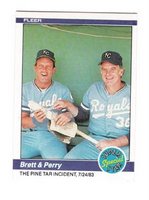
Actually, that’s it. Instead of trying to beat Topps at its own game, Fleer cranked out its by-then-trademark system of organization based on teams and order of finishing from the previous season (which is funny, because in the Fleer Update sets, the organization is by player last name, like the Topps roll call, instead of by team), with a few special cards at the end. Couple that with one of the strongest, non-flashy designs of the Fleer decade and you’ve got a winner.
14. 1989 Topps
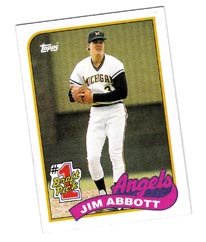 This was the last Topps set I routinely bought packs of. Oh sure, I collected full-time until 1995, but this set was Topps’ last great, pack-buying set. After this things got real complicated: inserts, better quality stock, a couple years of disappointing designs, plus after 1989 I had come to the realization that I probably shouldn’t buy packs just to buy them if I didn’t like the set. I was really into the 1990-94 Score sets, plus some of those Collectors Choice and Upper Deck sets from the mid-Nineties. I really liked the 1992 Topps design (their best of the decade) and bought the factory set on a special trip to Walgreens, and also wanted to like the 1993 and 1994 designs, but just couldn’t.
This was the last Topps set I routinely bought packs of. Oh sure, I collected full-time until 1995, but this set was Topps’ last great, pack-buying set. After this things got real complicated: inserts, better quality stock, a couple years of disappointing designs, plus after 1989 I had come to the realization that I probably shouldn’t buy packs just to buy them if I didn’t like the set. I was really into the 1990-94 Score sets, plus some of those Collectors Choice and Upper Deck sets from the mid-Nineties. I really liked the 1992 Topps design (their best of the decade) and bought the factory set on a special trip to Walgreens, and also wanted to like the 1993 and 1994 designs, but just couldn’t. So what made this set so great? Lots of stuff. The draft picks subset is a great place to start. Or we could start with the All-Star Rookies, of which there were plenty and plenty turned out to be great. In fact, this is one of the first sets where it’s obvious that Topps is obsessed with rookies: draft picks (Abbott, Avery, Ventura), all-star rookies (Grace, Sabo), future stars (Jeffries) and other, unmarked rookies (like the Randy Johnson).

Then there are the cheapish looking All-Star cards that took the varsity script design to new heights (or lows), certainly the first All-Star design most similar to the hallmark 1958 design. Seriously, compare the 1989 Clemens All-Star and the Musial All-Star from 1958; they’re very similar in composition. For what seems like the first time in the decade, the All-Star lineups were first-rate:
NL All Stars
386. Andres Galarraga, 1B f-HOF
387. Ryne Sandberg, 2B HOF
388. Bobby Bonilla, 3B
389. Ozzie Smith, SS HOF
390. Darryl Strawberry, OF
391. Andre Dawson, OF f-HOF
392. Andy Van Slyke, OF
393. Gary Carter, C HOF
394. Orel Hershiser, P f-HOF
395. Danny Jackson, P
396. Kirk Gibson, DH
AL All Stars
397. Don Mattingly, 1B f-HOF
398. Julio Franco, 2B f-HOF
399. Wade Boggs, 3B HOF
400. Alan Trammell, SS f-HOF
401. Jose Canseco, OF
402. Mike Greenwell, OF
403. Kirby Puckett, OF HOF
404. Bob Boone, C
405. Roger Clemens, P f-HOF
406. Frank Viola, P
407. Dave Winfield, DH HOF
HOF= Hall of Fame
f-HOF= Future Hall of Famer
Of these 20 guys, 6 are in the Hall of Fame and 7 are either virtual locks on admission or have a very good chance of induction before their cases go to the Veterans’ Committee. The weakest guy? Boone. He wasn’t even an All-Star in 1988—Terry Steinbach was the AL catcher, and he was the MVP of the game. So I guess the real loser here isn’t Bob Boone, it’s Steinbach for not getting an All-Star card.
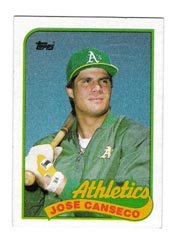
Or we could start with arguably the centerpiece of the set: #500 Jose Canseco. Canseco’s smug mug was on every box and you have to admit, this was right around the height of his power: coming off an awesome 1988 season and injured for most of the 1989 season, the Series against the Giants was his World Series, one where he hit .357—and really who could forget the grotesque pageant of him escorting his girlfriend/wife across the field after the earthquake?
In fact, the only thing I can think of that diminishes the strength of this set is the design of the backs of the cards: a hard, blush red and one of the hardest to read of the decade (probably second only to the green green green 1982 backs), especially in low light.
Anyway, to suggest just how great 1989 Topps is—despite the design—here’s a look at the rookies (or denoted rookies, even if they weren’t really rookies) in this set:
Jim Abbott*
Gregg Jeffries*
Chad Kreuter
Bill Bene
Mark Grace*
Willie Ansley
Darryl Hamilton
Roberto Alomar*
Bryan Harvey*
Gregg Olson*
Rob Dibble*
Sandy Alomar, Jr.*

Randy Johnson*
Mark Lemke
Ty Griffin
Gary Sheffield*
Ricky Jordan*
Carlos Quintana
Mark Lewis
Andy Benes*
Dante Bichette*
Mike Harkey
Robin Ventura*
Steve Avery*
Greg Briley
and I probably missed one or two…
*Guys worthy of rookie hype
 You could make an argument that all 25 of these guys, simply by having a denoted rookie card, were a part of rookie-related hype. But 15 out of the 25 were—however briefly—worthy of the hype. How often does that happen? We see it in the 1984 Traded sets, we see it in the 1986-87 rookie crop and now here in the 1988 update/rookie/traded and 1989 sets, and I’m not getting into 1980-83 because I honestly didn’t collect cards nor was conscious of too much baseball (I was 1 to 4 years old).
You could make an argument that all 25 of these guys, simply by having a denoted rookie card, were a part of rookie-related hype. But 15 out of the 25 were—however briefly—worthy of the hype. How often does that happen? We see it in the 1984 Traded sets, we see it in the 1986-87 rookie crop and now here in the 1988 update/rookie/traded and 1989 sets, and I’m not getting into 1980-83 because I honestly didn’t collect cards nor was conscious of too much baseball (I was 1 to 4 years old). And did you notice that this set doesn’t have a Griffey in it? His exclusion in this set doesn’t hurt its overall ranking, nor does it backfire and hurt the Traded set. I think it’s safe to say that despite the fact that the Randy Johnson rookie from 1989 Upper Deck is worth more than the entire 1989 Topps set, ’89 Topps doesn’t suffer lost value. It was fun to collect and buy packs even after I had doubles and triples of nearly every card, simply because there was enough reasons to do so: quality rookies, great All-Stars, enough stars and special subsets to choke a horse…just writing about it makes me want to go out and fork over the $11 for a rack box and just start ripping ’em open. Speaking of rack boxes, how about those glossy All-Stars? Can somebody explain why Ripken was in this set but not the SS in the fucking regular set? Anybody?
13. 1985 Fleer
 ’85 Fleer is one of those sets you read about in Beckett when you’re a little kid and you just know you’ll never be able to afford, then you read about it when you’re older and you still can’t afford it, and then, like an epiphany, you realize that you’re on salary and maybe you can afford to buy one or two packs of them, just to see what it was all about. Similarly, I only watched The Terminator for the first time a few years ago. And let me tell you, that was a fucking awesome movie. That guy in the trench coat, the one who Linda Hamilton has sex with and gets pregnant with, man he’s a fucking star in that film! Plus, didn’t Cameron score that movie himself? Anyway, like my searching out The Terminator and utterly enjoying the hell out of it, I searched out a pack of 1985 Fleer and will open it, right now (forget unopened pack value), just to see what it was all about (this is something I will be doing a lot of with the rest of the countdown).
’85 Fleer is one of those sets you read about in Beckett when you’re a little kid and you just know you’ll never be able to afford, then you read about it when you’re older and you still can’t afford it, and then, like an epiphany, you realize that you’re on salary and maybe you can afford to buy one or two packs of them, just to see what it was all about. Similarly, I only watched The Terminator for the first time a few years ago. And let me tell you, that was a fucking awesome movie. That guy in the trench coat, the one who Linda Hamilton has sex with and gets pregnant with, man he’s a fucking star in that film! Plus, didn’t Cameron score that movie himself? Anyway, like my searching out The Terminator and utterly enjoying the hell out of it, I searched out a pack of 1985 Fleer and will open it, right now (forget unopened pack value), just to see what it was all about (this is something I will be doing a lot of with the rest of the countdown).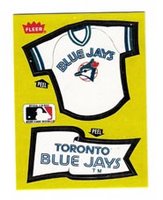
First impressions: The pack is pretty Fleer-esque; big lettering, the date exploding in a corner, plus you can see right through the wax wrapper…I think it’s a Blue Jays jersey sticker. Awesome! It says there are 15 cards in a pack, and that I could win either a complete set of cards and stickers, a ‘Fleer Team Contract’ or a $100 savings bond…the pack tore as I opened it…
Blue Jays Team Sticker
1. Barry Bonnell, Mariners I can’t remember if getting a Mariner as your first card is a good omen or a bad omen.
2. Mike Brown, Angels I don’t remember him at all, though he is sporting the gigantic, fuck-off Darrell Porter style eyeglasses, so that’s something.
3. Buddy Bell, Rangers He looks sedated and totally un-Buddy Bell-like, which is to say that he doesn’t resemble Ric Flair’s younger brother. Oh, but there is that shock of straw creeping down from under the cap, so there’s still a little Flair there.
4. Dale Berra, Pirates Man, this guy was a disaster, wasn’t he?
5. Mark Bailey, Astros Jesus, who are these guys? How did I manage to get a pack full of filler?
6. Bruce Bochte, A’s I’m getting a lot of double B names: Barry Bonnell, Buddy Bell, Bruce Bochte; actually, every name either is a double B or has at least one B in it…

7. Jose Roman/Joel Skinner, Major League Prospects Awesome! A rookies card! Wait a minute…who’s Jose Roman?
8. Andre Robertson, Yankees I’m halfway through this pack and I have to say: this pack sucks. Was this how all the packs collated in this set? I always thought these mid-1980s sets I missed out on were chockablock with Hall of Famers and Eric Davis rookie cards. But Buddy Bell? Is he really star enough to carry a pack?

9. Ken Phelps, Mariners This pack just got a little better because I got Ken Phelps. Check out his triangle offense of eyebrows and mustache, or perhaps his ridiculous smirk. And if ever there was a face made for glasses, it was Ken Phelps’. Phelps was good, right? Or am I thinking of Phil Bradley?

10. Phil Niekro, Yankees Finally, a star card! Good thing it’s not really a close-up; we all know Niekro wasn’t much to look at. This card also has got something weird going on with the coloring…his Yankee away jersey looks a little blue instead of grey. Oh well, that’s the charm of the Fleer printer I guess.
11. Moose Haas, Brewers This pack is now taking on legendary status. Well, that’s not true at all, but I just wanted to make sure you were still with me. Moose Haas: amateur locksmith, magician, baseball pitcher—the man would’ve fit better back in the Renaissance with the other renaissance men. Instead, he toiled for a hundred years in Milwaukee. That sounds like some kind of version of torture. Hey, you know, a lot of the photos in this set showcase the player against a consistently empty
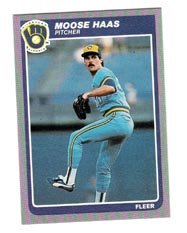 stadium backdrop, and it’s obvious that some of these photos were taken during games. Like Haas’ photo: there are people in the stands, but only 3 or 4. It’s like someone upstairs really had it in for the Fleer photographer (probably because of the 1982 set) and divined fans to stay home the day he or she had to take that year’s photos.
stadium backdrop, and it’s obvious that some of these photos were taken during games. Like Haas’ photo: there are people in the stands, but only 3 or 4. It’s like someone upstairs really had it in for the Fleer photographer (probably because of the 1982 set) and divined fans to stay home the day he or she had to take that year’s photos.12. Checklist, Brewers/Giants/Special Cards Awesome, a fucking checklist. Let’s see all the fun cards I’m not going to get in this pack: Fingers, Molitor, Yount, Sutton, Holland/Tunnell, Shawon Dunston/Billy Hatcher rookie prospects card, Kelly Gruber/Randy O’Neal rookie prospects card and Steve Keifer/Danny Tartabull rookie prospects card.
13. Jim Sundberg, Brewers Another Brewer in front of an empty ballpark. Great.
14. Bill Almon, A’s Awesome. Bill Almon.
15. Willie Hernandez, Tigers I guess he’s a star. He must be, because there are people in the stands for his photo.

Okay, so if we were to assign a success rating to this pack, we’ve got 15 cards and 6 cards that I would qualify as ‘good’. That’s a Success Rating of 40%, which actually isn’t bad when you reduce it to statistics. In no uncertain way is it a ‘Perfect Pack’ or even a ‘Good Pack’, and in fact if we were to assign each card a value this pack would get a 10 (3 x 3pt cards (Niekro, Rookie Prospects, Hernandez), 3 x 1pt cards (Bell, Haas, Phelps), 7 x 0pt cards (Brown, Almon, Sundberg, Robertson, Berra, Bailey, Bochte) and 2 x -1pt cards (Checklist, Bonnell)). Being Mariners hurts both Bonnell and Phelps. I would’ve made Phelps a 2pt card because he did hit for power in 1984 and is a funny looking grown man. Bonnell? I can’t help his rating. He’s nothing special, and when you’re nothing special on a last place team, you should consider yourself lucky that you only get a -1.
So 1985 Fleer rides in at #13 because of a decent, nothing-special design, strong, vibrant highlight colors and the rookie of one of the most consistently sought-after players over the last 20 years in Roger Clemens. All three sets benefited from the Clemens rookie (as all three did from Mattingly the year before), but his rookie meant much more to the success of Fleer than the other two simply because the set featured very little else.

You know, the more I think about these rankings, the less appeal these middle-decade Fleer sets have for me. They feel very base, and very empty. I wonder: if this set didn’t have a Clemens rookie, how would it fare? I’m talking long-term here, because there were any number of minor characters that had a valuable rookie here or there: Hershiser, for one, Eric Davis, Dwight Gooden, and I guess you could even lump Puckett into this category, though I feel kind of wary about lumping Puckett in the same class as Eric Davis. Actually, lets put Gooden and Puckett on a second tier and the others below them on a third tier. Gooden and Puckett had an easier time holding their value than the others, and then even they have taken a hit over the past few years. Clemens is the lone rookie to have kept his full value after all this time. But again, the question must be raised: Is 1985 Fleer a tent with only one tent pole? And what if the tent pole wasn’t there? Would it just be a pile of rags?
Coming Soon: 12 – 10

Great Blog! Speaking of rookies that got hyped and couldn't make it last, what about Dwight Smith and Kevin Seitzer?! They are 2 of my favorites to find in my old hard cases.
ReplyDeleteAs someone about your age and with a very similar card-collecting history, I love your blog. However, I must say you are using the term "future Hall of Famer" a bit loosley when applying to to Andres Galarraga and Orel Hershiser. And it pains me to say that because I grew up LOVING Orel. (That '89 Donruss card celebrating his scoreless innings is one of my favorites.)
ReplyDeleteI assume the picture of Eric Show was taken in much happier times. The poor guy wound up taking his own life in the end. Such a sad story. For a guy who used to sign autographs with bible verses, it was the last way I expected him to meet his demise.
ReplyDeleteJsut for kicks, my list of players who used to sign autographs with bible verses from my years of collecting...
Oddibe McDowell
Frank Tanana
Doug Jones
Tim Burke
Tom Herr
Alvin Davis
Eric Show
That's all I can remember right now.
Do not forget about the 84 fleer card of Glenn Hubbard where he has a Boa COnstrictor strapped around his neck. I remember where I was the first time I saw that card. Still one of my alltime faves.
ReplyDelete1985 Fleer is one of my favorites. I enjoy the design, the colors, and great selection. Plenty of Ripken cards too.
ReplyDeleteWax from that issue is impossible to find, but you can score hand-collated sets for about $35-40 at shows.
On a side note, you might consider as a wild card to the list, the 85 Leaf issue. Smaller and I woudl argue more efficient than its American counterpart, it still has all the key cards. And I really think the photos are clearer. It doesnt hurt that a wax box can yield multiple RC's of Clemens, Puckett, etc.
I always loved that '84 Fleer set, even more than the '85 version. Simple design, some great photos (that Glen Hubbard card mentioned above for one, and didn't it also have Jody Davis or somebody else on the Cubs wearing a ridiculous hat?). The Raines/Oliver double special card is ingenious (what a cool idea to get rid of the adjacent borders on those cards), and I'm pretty sure there was another one like it in the set (though I can't remember right now who it was).
ReplyDeleteI liked '89 Topps, but there are some odd color choices with the team names, and the color on that Canseco card is just surreal.
Willie Hernandez went from respectible set-up man for the Pennant-winning '83 Phillies, to lights-out closer of the World Champion '84 Tigers. He went 9-3 with 32 saves, a 1.92 ERA, had a WHIP below 1.00, and led the AL in appearances with 80. A dominating season that was good enough to earn him "Double Gold" (1984 AL MVP and Cy Young).
ReplyDeleteNeedless to say, if I had opened up this pack of '85 Fleer in 1985, and had found Hernandez, I'd have been pretty stoked. Now, Willie's just another common amongst many, in a 20-year-old pack.
Having now taken the time to go look, the card I was thinking of way Jay Johnstone, who is wearing an umbrella hat made of Budweiser labels.
ReplyDeleteAnd I think the other double card I was thinking of was Steve Sax/Dickie Thon.
while topps designs over the years have been a little art deco or avant garde, fleer's sense of design always seemed a little... well... corporate... the fleer font makes player names look like they were pulled right off a wallplate identifying the office of moose haas or jose roman...
ReplyDeletenowhere was this "corporate" style more evident than the 1984 set... it's not just basic, boring or utilitarian... it's just a bit too clean... if ever cards were made of professional accountants, 1984 fleer is exactly what they'd look like... I mean, can't you just picture rick dempsey in a suit and tie, turning away from his computer to mug for the camera? george brett and gaylord perry engaged in conversation at the water cooler? someone has to photoshop those bad boys...
Kelly Gruber is Eric Edelstein's hero. His most prized possession is his 1985 gem mint Fleer Major League Prospects rookie card with Randy O'Neal (No relation to Shaquille). The card is numbered 645 and is listed in Beckett at $1.00. He also enjoys Gruber's autobiography, Kelly: At home on Third. It is a great read. Nukes and Meatheads unite! War Jake Johnson and Rollie Fingers. Glenn Davis was a vastly underrated power hitter who remained drug-free.
ReplyDelete